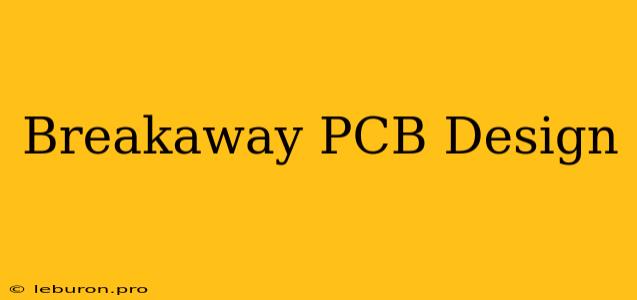The Art of Breakaway PCB Design: Maximizing Functionality and Flexibility
Breakaway printed circuit boards (PCBs) are a versatile and increasingly popular design solution, offering a unique combination of functionality and flexibility. They are commonly used in applications where multiple independent circuits need to be created from a single board. This allows for cost-effective production and efficient assembly, while still providing the ability to separate individual circuits for specific uses. This article will delve into the intricate world of breakaway PCB design, exploring its benefits, design considerations, and key factors to achieve optimal performance.
Understanding Breakaway PCB Design
Breakaway PCBs are essentially single boards with pre-defined break lines that enable clean and precise separation into multiple smaller boards. These break lines, often incorporated using scoring or v-grooving techniques, facilitate easy separation without compromising the integrity of the individual circuits. This approach allows for a flexible design where multiple components can be manufactured on a single board and then easily separated into functional units.
Benefits of Breakaway PCB Design
The use of breakaway PCBs offers several advantages:
- Cost Reduction: By manufacturing multiple circuits on a single board, the overall production cost is reduced. This is due to decreased material usage and efficient assembly processes.
- Flexibility and Customization: Breakaway PCBs provide the flexibility to create custom boards by separating individual units according to specific requirements. This allows for greater design freedom and the ability to easily adapt to changing needs.
- Increased Efficiency: The ease of separation simplifies the assembly process, reducing the time and resources needed to manufacture and test individual circuits.
- Space Optimization: Breakaway PCBs allow for compact designs where multiple circuits can be housed in a single board, maximizing space utilization and minimizing footprint.
- Reduced Waste: By minimizing the need for individual boards, breakaway PCBs contribute to a more sustainable manufacturing process, reducing material waste and associated environmental impact.
Key Considerations for Breakaway PCB Design
While offering numerous benefits, breakaway PCB design requires careful planning and attention to specific considerations to ensure optimal performance:
1. Material Selection
The choice of PCB material is crucial for breakaway design. Breakaway PCBs are typically manufactured using FR-4, a commonly used fiberglass epoxy laminate known for its strength and electrical properties. However, other materials like polyimide or flexible substrates can be employed depending on the specific application requirements.
2. Break Line Design
The design of the break lines is critical for achieving a clean and reliable separation. Breakaway PCBs commonly use scoring or v-grooving techniques to create these lines.
- Scoring: This involves creating a shallow groove along the break line, weakening the material and allowing for separation.
- V-Grooving: This technique involves creating a V-shaped groove that provides a defined break line and facilitates clean separation.
3. Design Rules for Breakaway PCBs
Breakaway PCB design requires adhering to specific design rules for successful separation:
- Break Line Width: The width of the break line should be adequate to prevent accidental separation during handling and to facilitate a clean break.
- Break Line Spacing: Ensure sufficient spacing between adjacent break lines to prevent unintended connections or damage during separation.
- Break Line Placement: Carefully position the break lines to avoid critical components or areas that require intact connections.
- Copper Trace Considerations: Avoid placing copper traces directly over the break lines to prevent damage during separation.
4. Manufacturing Considerations
The manufacturing process for breakaway PCBs needs to be carefully controlled to ensure consistent and reliable separation:
- Scoring/V-Grooving: The scoring or v-grooving depth and accuracy must be consistent to achieve a clean separation.
- Solder Mask: The solder mask should be properly applied and aligned to prevent accidental connections between components after separation.
- Plating and Finishing: The plating and finishing processes should consider the required electrical properties and surface characteristics of the individual circuits.
5. Testing and Validation
Thorough testing and validation of breakaway PCBs are essential before production. This includes:
- Electrical Testing: Verify the electrical performance of each individual circuit after separation.
- Mechanical Testing: Perform mechanical tests to ensure the integrity of the break lines and the strength of the individual circuits.
- Visual Inspection: Conduct visual inspection to confirm the quality of the scoring or v-grooving, solder mask, and overall board construction.
Applications of Breakaway PCB Design
Breakaway PCBs have proven to be valuable in a wide range of applications:
- Consumer Electronics: Breakaway PCBs are commonly used in devices like smartphones, tablets, and other portable electronics, enabling the creation of smaller, modular components.
- Industrial Applications: Breakaway PCBs are employed in industrial control systems, sensors, and actuators, allowing for flexible and customized designs.
- Medical Devices: In the medical industry, breakaway PCBs find applications in diagnostic equipment, monitoring devices, and other healthcare solutions, enabling the creation of compact and reliable modules.
- Automotive: Breakaway PCBs are used in automotive electronics, such as vehicle control systems, entertainment systems, and safety systems, facilitating modular design and efficient assembly.
Conclusion
Breakaway PCB design provides a compelling solution for manufacturers looking to optimize functionality and flexibility in their products. By carefully considering the design considerations, manufacturing processes, and testing requirements, breakaway PCBs can contribute to cost reduction, increased efficiency, and greater design freedom. As the demand for smaller, more modular electronic systems continues to grow, breakaway PCB design is poised to play an increasingly important role in shaping the future of electronics manufacturing.
